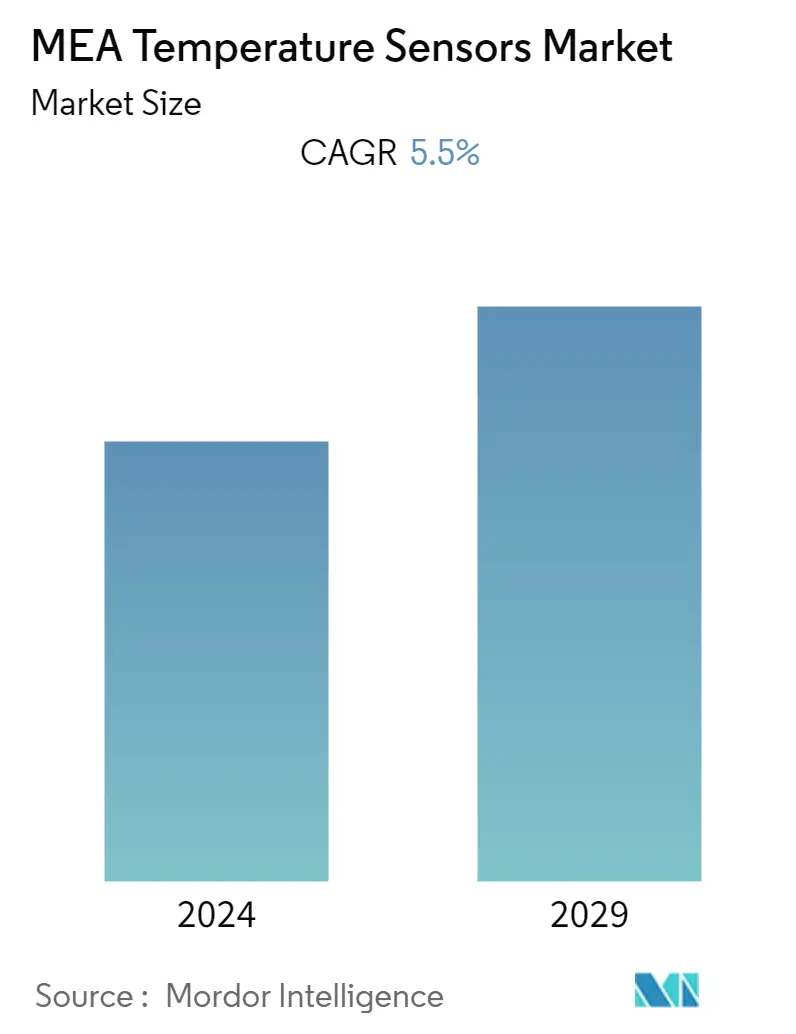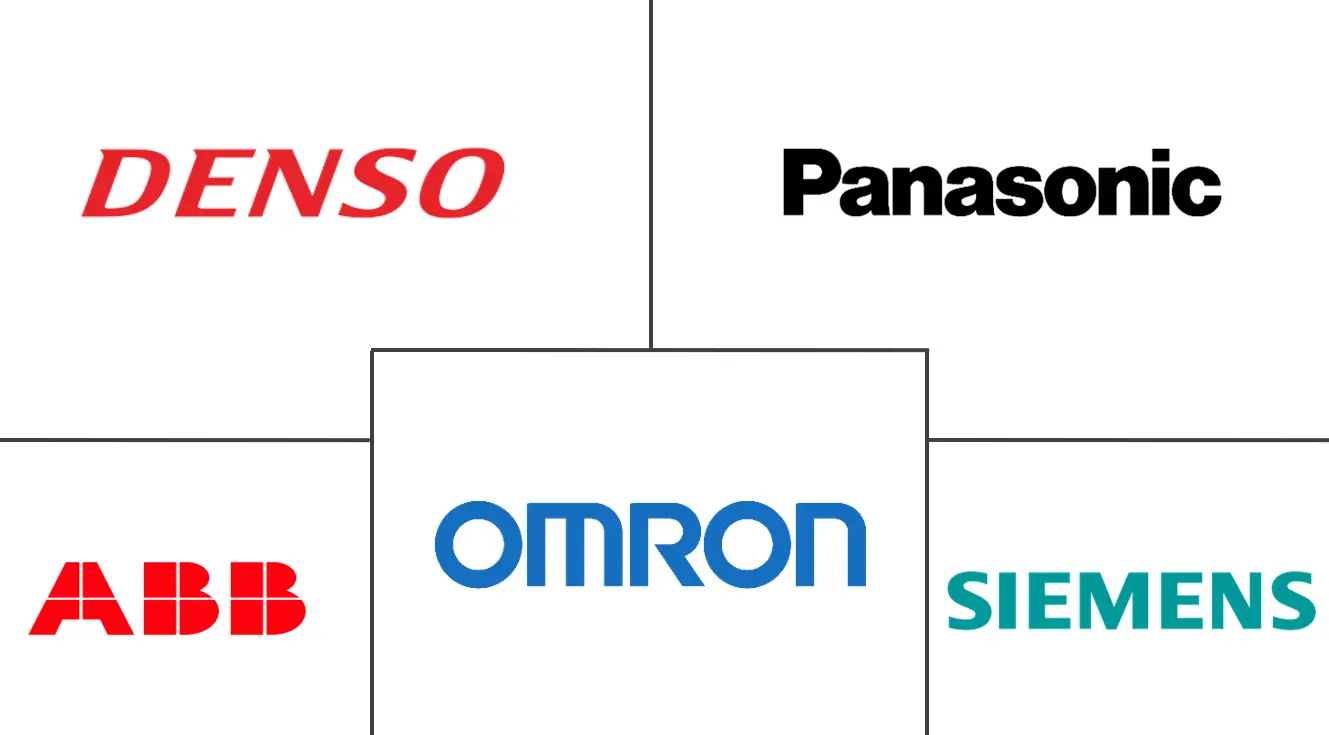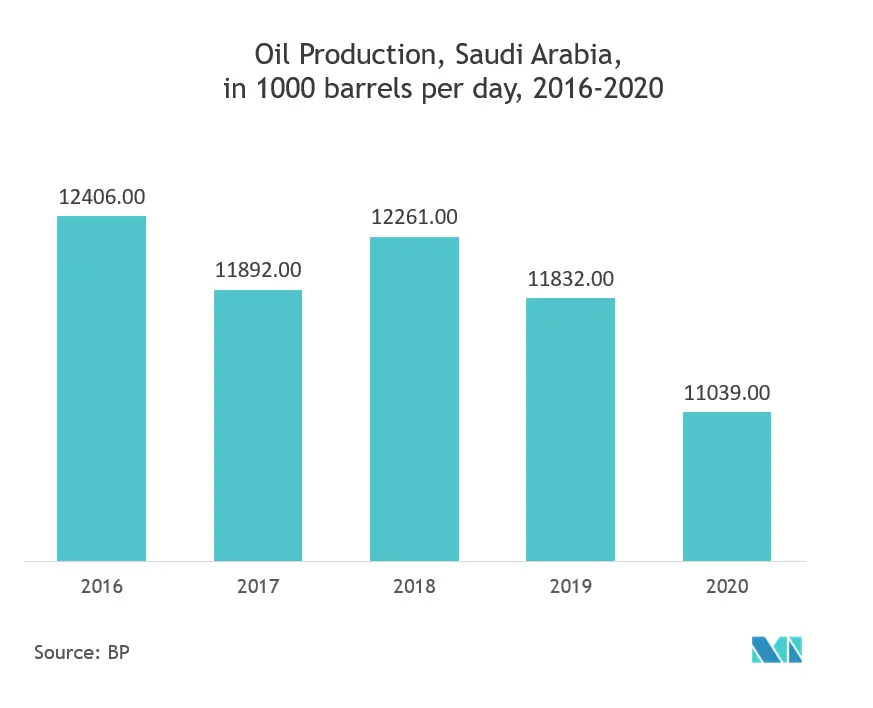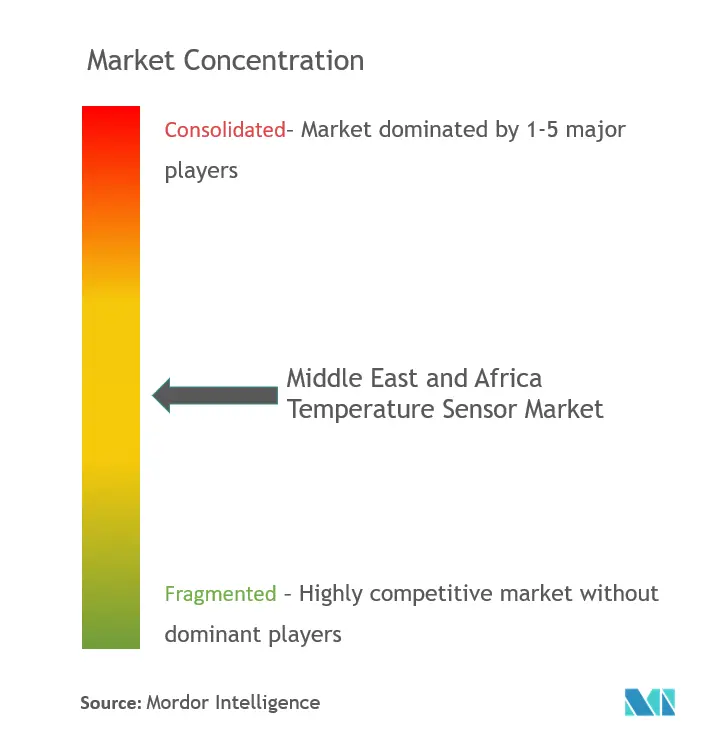MEA Temperature Sensors Market Size

| Study Period | 2019 - 2029 |
| Base Year For Estimation | 2023 |
| Forecast Data Period | 2024 - 2029 |
| Historical Data Period | 2019 - 2022 |
| CAGR | 5.50 % |
| Market Concentration | Medium |
Major Players
*Disclaimer: Major Players sorted in no particular order |
MEA Temperature Sensors Market Analysis
The Middle East and Africa, temperature sensor market, was valued at USD 674.8 million in 2020, and it is projected to be worth USD 931.6 million by 2026, registering a CAGR of 5.5% during the period 2021-2026.
- The region is one of the fastest-growing manufacturing industries in the region. Due to the government's anchor projects, low taxes, and business-friendly regulations, significant manufacturers of temperature sensors are expected to invest in the country.
- The United Arab Emirates has one of the robust automotive sectors in the GCC due to factors such as low import tariffs and low fuel costs. Dubai is expected to spend Millions of Dirhams on incentives to have 42,000 EVs on its streets by 2030. General Motors expects to see increased sales in the region with the launch of its Chevrolet electric vehicle. Besides, Dubai Police also operates a small fleet of Bolt EVs.
- Moreover, Saudi Arabia aims to shift from its oil-based economy and is in talks with Jordan and Egypt for a USD 500 billion industrial zone powered by renewable energy. Known as NEOM, the zone will focus on industries, including energy and water, biotechnology, food, and advanced manufacturing, propelling the demand for automation and encouraging the industry players to invest in the region.
- Due to the outbreak of COVID-19, the global supply chain and demand for multiple products have majorly been disrupted, due to which wireless temperature sensors adoption is anticipated to be influenced until the end of the year 2020. However, the growing demand for medical applications is driving the market growth. Various players are investing and collaborating to cater to the requirements.
MEA Temperature Sensors Market Trends
This section covers the major market trends shaping the MEA Temperature Sensors Market according to our research experts:
Automotive industry to Show Significant Growth
- The United Arab Emirates has one of the robust automotive sectors in the GCC due to factors such as low import tariffs and low fuel costs. Dubai is expected to spend Millions of Dirhams on incentives to have 42,000 EVs on its streets by 2030. General Motors expects to see increased sales in the region with the launch of its Chevrolet electric vehicle. Besides, Dubai Police also operates a small fleet of Bolt EVs.
- The government has announced that it aims to invest USD 75 billion by 2025 in the country's new industrial manufacturing sector and that the manufacturing sector would contribute 25% toward the country's GDP by 2025. General Motors is planning to launch 20 new electric vehicle models globally by 2023 and intends to market the UAE product line. The UAE government targets up to a 15% reduction in carbon emissions by 2020 and a 20% adoption of EVs within its fleet, making the automotive sector one of the prominent users of temperature sensors in the region.
- Moreover, The automotive industry has pushed the government to create a market for electric vehicles in South Africa. Nissan and BMW have been pushing the South African government to reduce the import duty on electric vehicles to make them more affordable. In September 2019, GridCars, one of the largest installers of public electric vehicle charging stations in South Africa, completed its national EV highway rollout that connects significant cities along some of South Africa's busiest highways. In November 2019, Airports Company South Africa (ACSA), in partnership with BMW SA, announced EV charging stations across three ACSA's airports in the country. Such developments will make the automotive sector a significant end-user of temperature sensors.

Oil and Gas to Hold the Highest Market Share
- The region is witnessing the continuous discovery of new oil and gas wells while the old and underutilized ones are rejuvenated. For instance, in November 2019, the government-owned company, Abu Dhabi National Oil Co. (ADNOC), announced a significant rig fleet expansion program, which is expected to add dozens of rigs by 2025. The company also claims to have increased its gas reserves to about 273 trillion cubic feet (TCF), owing to the discovery of unconventional gas deposits in the region. Such increasing developments are driving the demand for temperature sensors.
- On the other hand, Saudi Arabia is one of the world's largest producers and exporters of petroleum liquids, which is currently the world's second-largest crude oil producer, right after Russia. The Saudi Arabian economy remains heavily dependent on oil- and petroleum-related industries, including petrochemicals and petroleum refining, making the oil and gas sector one of the prominent users of temperature sensors in the country.
- Moreover, Kuwait signed a USD 600 Million offshore exploration contract with Halliburton to drill six high-pressure, high-temperature (HP/HT) exploration wells in the next two to three years. This new offshore exploration project with Halliburton could help add around 100,000 barrels of oil per day in the future. The offshore exploration work was anticipated to start in mid-2020, with the first rig anticipated to come by July 2020 and the second rig by January 2021. Such developments are expected to drive the market's growth positively.
- New exploration activities are being witnessed in Oman, which is expected to impact the market positively. For instance, BP and Eni signed an E&P agreement for Block 77. This is anticipated to result in an 8.0% increase in drilling activity. In December 2020, Oman created a new upstream oil and gas company known as Energy Development Oman (EDO), which will take a stake in the country's more established energy company, Petroleum Development Oman (PDO), and develop its projects.

MEA Temperature Sensors Industry Overview
The Middle East and Africa Temperature Sensor market is moderately competitive and consists of a few major players. In terms of market share, some of the players currently dominate the market. However, with the advancement in the measurement and assessment of the electronic component, new players are increasing their market presence, thereby expanding their business footprint across the emerging economies.
- August 2021 - A Dubai school's five pupils have created a handy device and sterilization materials that can be used on an institution's door handles to prevent the spread of the raging Covid-19 outbreak and enhance their peers' public health safety further. The pupils relied on the fact that the door has equipment that produces kinetic energy. They also added Arduino-based temperature sensors and an LED screen in a bid to monitor the temperature of all those passing through the door.
MEA Temperature Sensors Market Leaders
-
Siemens AG
-
PANASONIC CORPORATION
-
ABB LIMITED
-
DENSO CORPORATION
-
Omron CORPORATION
*Disclaimer: Major Players sorted in no particular order

MEA Temperature Sensors Market News
- August 2021 - Communications Minister Yoaz Hendel and representatives from Google announced the official launch of the "Blue Raman" route that will link the two countries, part of a larger internet infrastructure project that will ultimately connect Europe with India through fiber optics.
MEA Temperature Sensors Market Report - Table of Contents
1. INTRODUCTION
- 1.1 Study Assumptions and Market Definition
- 1.2 Scope of the Study
2. RESEARCH METHODOLOGY
3. EXECUTIVE SUMMARY
4. MARKET DYNAMICS
- 4.1 Market Overview
- 4.2 Assessment of Impact of COVID-19 on the Industry
-
4.3 Market Drivers
- 4.3.1 Growth in Industry 4.0 & Rapid Factory Automation
- 4.3.2 Increasing Demand for Wearable in Consumer Electronics
-
4.4 Market Restraints
- 4.4.1 Fluctuation in Raw Material Prices
- 4.5 Industry Value Chain Analysis
-
4.6 Industry Attractiveness - Porter's Five Force Analysis
- 4.6.1 Bargaining Power of Suppliers
- 4.6.2 Bargaining Power of Buyers
- 4.6.3 Threat of New Entrants
- 4.6.4 Threat of Substitute Products
- 4.6.5 Intensity of Competitive Rivalry
5. MARKET SEGMENTATION
-
5.1 By Type
- 5.1.1 Wired
- 5.1.2 Wireless
-
5.2 By Technology
- 5.2.1 Infrared
- 5.2.2 Thermocouple
- 5.2.3 Resistance Temperature Detector
- 5.2.4 Thermistor
- 5.2.5 Temperature Transmitter
- 5.2.6 Fiber Optic
- 5.2.7 Others
-
5.3 By End-user Industry
- 5.3.1 Chemical and Petrochemical
- 5.3.2 Oil and Gas
- 5.3.3 Metal and Mining
- 5.3.4 Power Generation
- 5.3.5 Food and Beverage
- 5.3.6 Automotive
- 5.3.7 Medical
- 5.3.8 Aerospace and Military
- 5.3.9 Consumer Electronics
- 5.3.10 Other End-user Industries
-
5.4 By Country
- 5.4.1 UAE
- 5.4.2 Saudi Arabia
- 5.4.3 Rest of Middle East and Africa
6. COMPETITIVE LANDSCAPE
-
6.1 Company Profiles
- 6.1.1 Siemens AG
- 6.1.2 Panasonic Corporation
- 6.1.3 Texas Instruments Incorporated
- 6.1.4 Honeywell International Inc.
- 6.1.5 ABB Ltd
- 6.1.6 Analog Devices Inc.
- 6.1.7 Fluke Process Instruments
- 6.1.8 Emerson Electric Company
- 6.1.9 STMicroelectronics
- 6.1.10 Microchip Technology Incorporated
- 6.1.11 NXP Semiconductors NV
- 6.1.12 GE Sensing & Inspection Technologies GmbH
- 6.1.13 Robert Bosch GmbH
- 6.1.14 Gunther GmbH Temperaturmesstechnik
- 6.1.15 TE Connectivity Ltd
- 6.1.16 Denso Corporation
- 6.1.17 Omron Corporatio
- 6.1.18 FLIR Systems
- 6.1.19 Thermometris
- 6.1.20 Maxim Integrated Products
- 6.1.21 Kongsberg Gruppen
- *List Not Exhaustive
7. INVESTMENT ANALYSIS
8. FUTURE OF THE MARKET
** Subject To AvailablityMEA Temperature Sensors Industry Segmentation
The temperature sensors are devices to measure temperature readings through electrical signals. The sensor is made of two metals that generate electrical voltage or resistance once it notices a temperature change. The temperature sensors have various types based on the technology type, such as Infrared, Thermocouple, Resistance Temperature Detectors (RTD), Thermistor, and others.
The report describes the type of sensors, such as wired and wireless, and also provides the study of output, which are analog and digital. The end-user industry is comprised of temperature sensor applications, and majorly includes Chemical & Petrochemical, Oil & Gas, Metal & Mining, Power Generation, Food & Beverage, Automotive, Medical, Aerospace & Military, and others. The study is also being provided based on the COVID-19 impact.
MEA Temperature Sensors Market Research FAQs
What is the current MEA Temperature Sensors Market size?
The MEA Temperature Sensors Market is projected to register a CAGR of 5.5% during the forecast period (2024-2029)
Who are the key players in MEA Temperature Sensors Market?
Siemens AG , PANASONIC CORPORATION , ABB LIMITED , DENSO CORPORATION and Omron CORPORATION are the major companies operating in the MEA Temperature Sensors Market.
What years does this MEA Temperature Sensors Market cover?
The report covers the MEA Temperature Sensors Market historical market size for years: 2019, 2020, 2021, 2022 and 2023. The report also forecasts the MEA Temperature Sensors Market size for years: 2024, 2025, 2026, 2027, 2028 and 2029.
MEA Temperature Sensor Industry Report
Statistics for the 2023 MEA Temperature Sensor market share, size and revenue growth rate, created by Mordor Intelligence™ Industry Reports. MEA Temperature Sensor analysis includes a market forecast outlook to 2029 and historical overview. Get a sample of this industry analysis as a free report PDF download.



